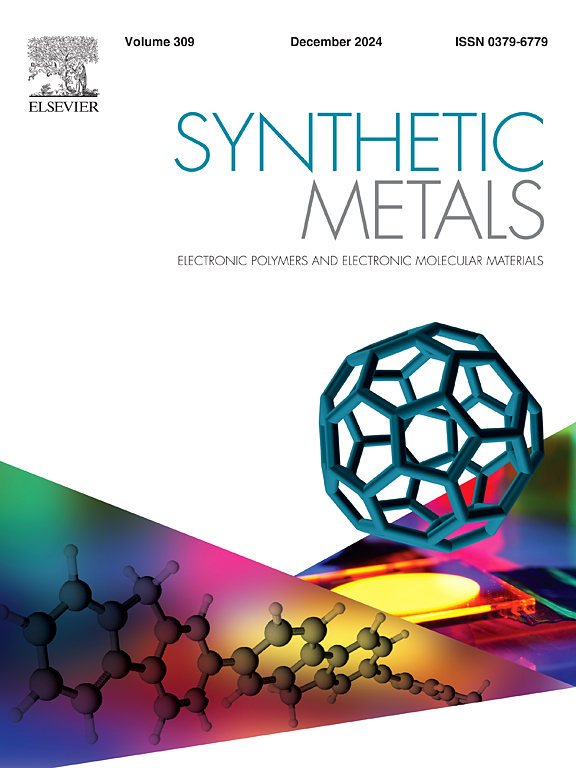使用 TEMPOL 衍生物提高溶液处理有机发光二极管的性能
IF 4.6
3区 材料科学
Q2 MATERIALS SCIENCE, MULTIDISCIPLINARY
引用次数: 0
摘要
本研究报告了在广泛使用的空穴注入/传输聚(3,4-亚乙二氧基噻吩):聚苯乙烯磺酸盐(PEDOT:PSS)层中溶液加工的新型 4-羟基-2,2,6,6-四甲基哌啶-1-氧(TEMPOL)衍生有机化合物。通过一步化学程序合成的 TEMPOL 衍生有机掺杂剂具有独特的分子偶极特性和导电性。与基于原始 PEDOT:PSS 层的器件相比,采用 4-苯磺酰基-2,2,6,6-四甲基-1-哌啶氧基自由基(TBS)掺杂 PEDOT:PSS 层的绿色有机发光二极管(OLED)的最大功率效率(PEmax)为 25.58 lm W-1,最大外部量子效率(EQEmax)为 12.19 %,最大电流效率(CEmax)为 40.85 cd A-1,均有显著提高。在相同条件下,纤维 OLED 也获得了 PEmax(16.18 lm W-1)、EQEmax(10.67 %)和 CEmax(37.01 cd A-1)。OLED 性能的提高可归因于阳极和发射层界面的空穴注入势垒降低。本文章由计算机程序翻译,如有差异,请以英文原文为准。
Enhanced performance of solution-processed organic light-emitting diodes with TEMPOL derivatives
This study reports novel solution-processed 4-hydroxy-2,2,6,6-tetramethylpiperidin-1-oxyl (TEMPOL)-derivative organic compounds in a widely employed hole-injection/transport poly(3,4-ethylenedioxythiophene):polystyrene sulfonate (PEDOT:PSS) layer. The TEMPOL-derived organic dopants, synthesized via a one-step chemical procedure, exhibited distinctive molecular dipole characteristics and electrical conductivities. The green organic light-emitting diodes (OLEDs) with a 4-benzene sulfonyl-2,2,6,6-tetramethyl-1-piperidenyloxy radical (TBS)-doped PEDOT:PSS layer exhibited a maximum power efficiency (PEmax) of 25.58 lm W−1, maximum external quantum efficiency (EQEmax) of 12.19 %, and maximum current efficiency (CEmax) of 40.85 cd A−1, demonstrating significant improvements compared with the pristine PEDOT:PSS layer-based device. The PEmax (16.18 lm W−1), EQEmax (10.67 %), and CEmax (37.01 cd A−1) were obtained with fiber OLEDs under same conditions. This enhancement in OLED performance can be attributed to the decreased hole-injection barrier at the anode and emissive layer interfaces.
求助全文
通过发布文献求助,成功后即可免费获取论文全文。
去求助
来源期刊

Synthetic Metals
工程技术-材料科学:综合
CiteScore
8.30
自引率
4.50%
发文量
189
审稿时长
33 days
期刊介绍:
This journal is an international medium for the rapid publication of original research papers, short communications and subject reviews dealing with research on and applications of electronic polymers and electronic molecular materials including novel carbon architectures. These functional materials have the properties of metals, semiconductors or magnets and are distinguishable from elemental and alloy/binary metals, semiconductors and magnets.
 求助内容:
求助内容: 应助结果提醒方式:
应助结果提醒方式:


